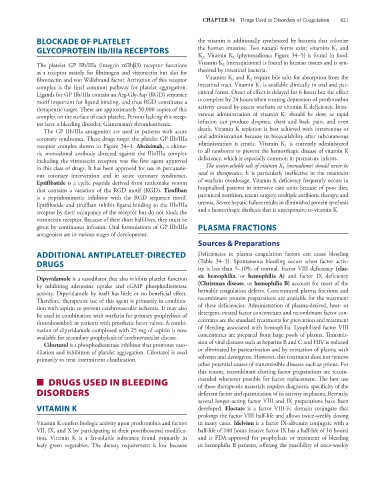Page 635 - Basic _ Clinical Pharmacology ( PDFDrive )
P. 635
CHAPTER 34 Drugs Used in Disorders of Coagulation 621
BLOCKADE OF PLATELET the vitamin is additionally synthesized by bacteria that colonize
GLYCOPROTEIN IIb/IIIa RECEPTORS the human intestine. Two natural forms exist: vitamins K and
1
K . Vitamin K (phytonadione; Figure 34–5) is found in food.
1
2
The platelet GP IIb/IIIa (integrin αIIbβ3) receptor functions Vitamin K (menaquinone) is found in human tissues and is syn-
2
as a receptor mainly for fibrinogen and vitronectin but also for thesized by intestinal bacteria.
fibronectin and von Willebrand factor. Activation of this receptor Vitamins K and K require bile salts for absorption from the
2
1
complex is the final common pathway for platelet aggregation. intestinal tract. Vitamin K is available clinically in oral and par-
1
Ligands for GP IIb/IIIa contain an Arg-Gly-Asp (RGD) sequence enteral forms. Onset of effect is delayed for 6 hours but the effect
motif important for ligand binding, and thus RGD constitutes a is complete by 24 hours when treating depression of prothrombin
therapeutic target. There are approximately 50,000 copies of this activity caused by excess warfarin or vitamin K deficiency. Intra-
complex on the surface of each platelet. Persons lacking this recep- venous administration of vitamin K should be slow, as rapid
1
tor have a bleeding disorder, Glanzmann’s thrombasthenia. infusion can produce dyspnea, chest and back pain, and even
The GP IIb/IIIa antagonists are used in patients with acute death. Vitamin K repletion is best achieved with intravenous or
coronary syndromes. These drugs target the platelet GP IIb/IIIa oral administration because its bioavailability after subcutaneous
receptor complex shown in Figure 34–1. Abciximab, a chime- administration is erratic. Vitamin K is currently administered
1
ric monoclonal antibody directed against the IIb/IIIa complex to all newborns to prevent the hemorrhagic disease of vitamin K
including the vitronectin receptor, was the first agent approved deficiency, which is especially common in premature infants.
in this class of drugs. It has been approved for use in percutane- The water-soluble salt of vitamin K (menadione) should never be
3
ous coronary intervention and in acute coronary syndromes. used in therapeutics. It is particularly ineffective in the treatment
Eptifibatide is a cyclic peptide derived from rattlesnake venom of warfarin overdosage. Vitamin K deficiency frequently occurs in
that contains a variation of the RGD motif (KGD). Tirofiban hospitalized patients in intensive care units because of poor diet,
is a peptidomimetic inhibitor with the RGD sequence motif. parenteral nutrition, recent surgery, multiple antibiotic therapy, and
Eptifibatide and tirofiban inhibit ligand binding to the IIb/IIIa uremia. Severe hepatic failure results in diminished protein synthesis
receptor by their occupancy of the receptor but do not block the and a hemorrhagic diathesis that is unresponsive to vitamin K.
vitronectin receptor. Because of their short half-lives, they must be
given by continuous infusion. Oral formulations of GP IIb/IIIa PLASMA FRACTIONS
antagonists are in various stages of development.
Sources & Preparations
ADDITIONAL ANTIPLATELET-DIRECTED Deficiencies in plasma coagulation factors can cause bleeding
DRUGS (Table 34–3). Spontaneous bleeding occurs when factor activ-
ity is less than 5–10% of normal. Factor VIII deficiency (clas-
sic hemophilia, or hemophilia A) and factor IX deficiency
Dipyridamole is a vasodilator that also inhibits platelet function
by inhibiting adenosine uptake and cGMP phosphodiesterase (Christmas disease, or hemophilia B) account for most of the
activity. Dipyridamole by itself has little or no beneficial effect. heritable coagulation defects. Concentrated plasma fractions and
Therefore, therapeutic use of this agent is primarily in combina- recombinant protein preparations are available for the treatment
tion with aspirin to prevent cerebrovascular ischemia. It may also of these deficiencies. Administration of plasma-derived, heat- or
be used in combination with warfarin for primary prophylaxis of detergent-treated factor concentrates and recombinant factor con-
thromboemboli in patients with prosthetic heart valves. A combi- centrates are the standard treatments for prevention and treatment
nation of dipyridamole complexed with 25 mg of aspirin is now of bleeding associated with hemophilia. Lyophilized factor VIII
available for secondary prophylaxis of cerebrovascular disease. concentrates are prepared from large pools of plasma. Transmis-
Cilostazol is a phosphodiesterase inhibitor that promotes vaso- sion of viral diseases such as hepatitis B and C and HIV is reduced
dilation and inhibition of platelet aggregation. Cilostazol is used or eliminated by pasteurization and by extraction of plasma with
primarily to treat intermittent claudication. solvents and detergents. However, this treatment does not remove
other potential causes of transmissible diseases such as prions. For
this reason, recombinant clotting factor preparations are recom-
■ DRUGS USED IN BLEEDING mended whenever possible for factor replacement. The best use
of these therapeutic materials requires diagnostic specificity of the
DISORDERS deficient factor and quantitation of its activity in plasma. Recently,
several longer-acting factor VIII and IX preparations have been
VITAMIN K developed. Eloctate is a factor VIII-Fc domain conjugate that
prolongs the factor VIII half-life and allows twice-weekly dosing
Vitamin K confers biologic activity upon prothrombin and factors in many cases. Idelvion is a factor IX-albumin conjugate with a
VII, IX, and X by participating in their postribosomal modifica- half-life of 100 hours (native factor IX has a half-life of 16 hours)
tion. Vitamin K is a fat-soluble substance found primarily in and is FDA-approved for prophylaxis or treatment of bleeding
leafy green vegetables. The dietary requirement is low because in hemophilia B patients, offering the possibility of once-weekly

